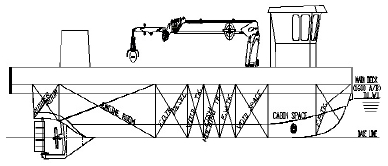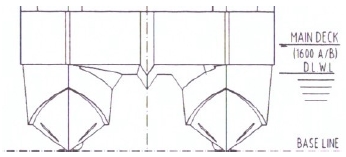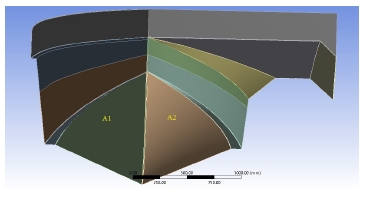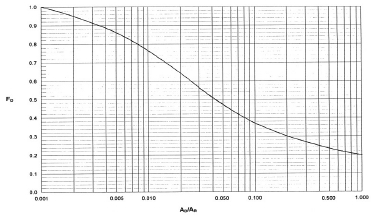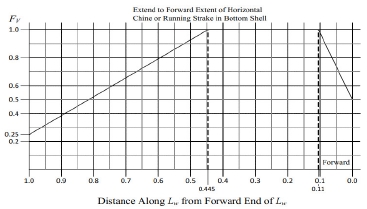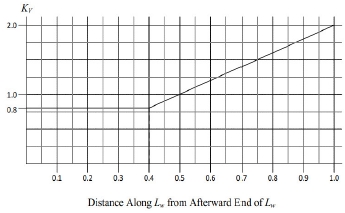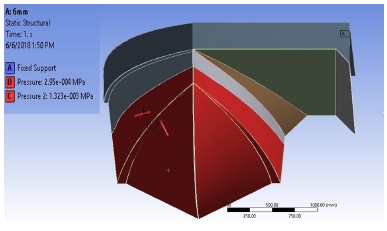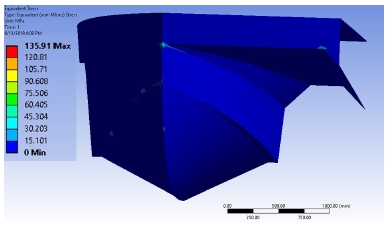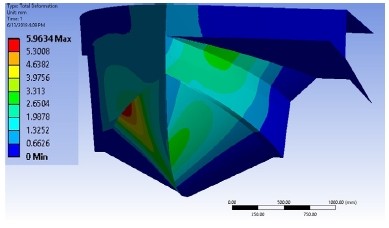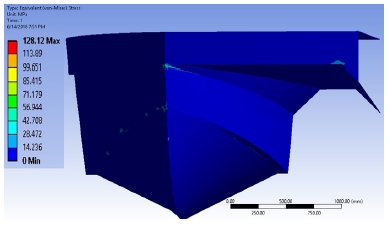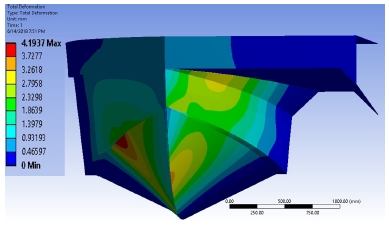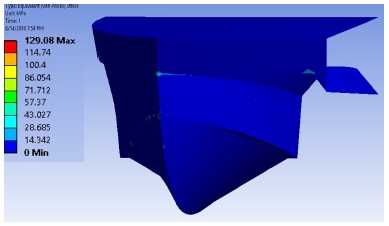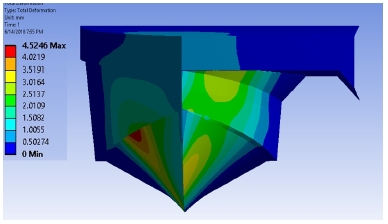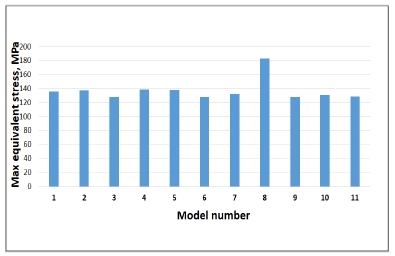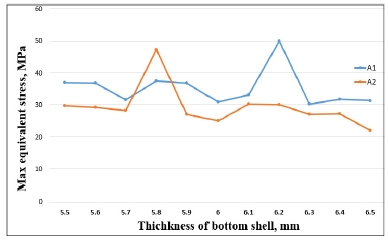
Structural Analysis of a Catamaran’s Forward Shell Due to Slamming Pressure Based on Finite Element Method
Abstract
This paper presents the analysis of slamming impact pressure on a catamaran ship’s hull. The determined amount of impact pressure follows the American Bureau of Shipping (ABS) guide. A forward shell is an important part of the ship hull where the most effects of slamming pressure impact on the voyage. The effects of slamming pressure on the forward shell of a catamaran ship are based on finite element method (FEM). From these results it is possible to assess the durability of the forward shell.
Keywords:
Forward shell, Catamaran ship, Structure analysis, Finite Element Method (FEM)1. Introduction
Traveling of a ship in rough sea water impact to the ship because large vertical relative motions between the ship and the water surface. The Slamming phenomenon is the impact of ship bottom on the water surface with a high velocity.
Slamming is very complex problem and so far, there has been a lot of research on the effect slamming on the ship hull that can be mentioned: Slamming impact design load on large high speed naval craft (2008) by Sungeun Kim [1]. In which they determined impact load to the hull of naval craft by numerical method and combined model test. This method was done by Ahmad and Wipowo HN (2014) with an application of a different hull form of frigate [2]. This study has been successfully presented a method for predicting slamming pressure on a typical frigate hull for design purpose. H.Gao and P.Hu studied evaluation on composite hull structure subjected to slamming load [3]. In their studies, Structural response of local hull structure under evenly distributed with FEM and the calculated results were compared with their experimental works. Bo Cao and Dong-Jun Kim studied about structure of yacht. They studied based on the guidelines suggested by the ABS [4]. This research has investigated the strength of the hull and keel of sailing yacht.
The determining amount of impact pressure is essential for purposes of hull structure design. There are many methods for studying the impact load on the ship hull. Experimental techniques areuseful but these one are very expensive because they require a ship model and test devices. Hence, the FEM is available for studying the ship structure design.
In this paper, a forward shell of catamaran ship was designed and analyzed by using ANSYS software. The slamming pressure can be calculated according to the ABS guide for ship building 2016 [5].
2. Model design
The ship studied in this research was a 17 meter catamaran ship. The ship profile is shown in Fig. 1 and the principal dimensions of this ship are given in Table 1.
When the ship is sailing in rough sea the forward shell of hull is most affected by slamming pressure and therefore it is selected to design 3D model as shown in Fig. 2
Because the catamaran hull is symmetrical so that half of forward part was selected to design 3D model. The area of bottom hull area are A1 = A2 = 3.03 m2 as shown in Fig. 3.
One of the most integral of the catamaran ship is bottom structure. It is designed not only to enough strength to withstand the weight of cargo, but also to withstand the external hydrostatic loads and slamming loads that acts on the bottom of the hull. A total of eleven models were designed, each of ones was established by varying the thickness of bottom plates A1 and A2 from 5.5 mm to 6.5 mm. The changing value is 0.1 mm, while the thickness of other shell is kept constantly at 5.0 mm. The thickness of two bottom shells was changed so that total of model mass was constant. The designed models are given in table 2. Aluminum alloy was used to make catamaran hull and material properties were shown in Table 3.
3. Determine slamming pressure
3.1 Bottom slamming pressure
| (1) |
Where ncg= Vertical acceleration of ship determined by a model test or the following formula using the average 1/100 highest vertical at LCG:
| (2) |
N1= 0.01;
∆= Displacement at design WL, in kg;
Lw= Length on the water line at the design displacement mode, in m;
Bw= Maximum water line beam, in m;
FD= 0.4: design area factor given in Fig. 4 for given values of design are (AD) and reference area (AR);
FV= 0.5: vertical acceleration distribution factor given in Fig. 5;
N2= 2: number of hulls
τ= running trim at V, in degrees;
V= maximum design speed at calm water, in knots;
βcg= deadries at LCG, degrees (270)
3.2 Side slamming pressure
| (3) |
Where
nxx=ncgKV average of 1/100 highest vertical acceleration at any section clear of LCG, in g’s;
βsx= Deadrise of side shell at any section clear of LCG, in degrees;
KV= 1.2 Vertical acceleration distribution factor give in Fig. 6.
4. Structure analysis
4.1 Meshing and boundary condition
After designing the model is meshed and the last step to be completed before meshing the model is setting the mesh control such as size function, element shape. The face meshing is selected to mesh this model.
The pressure load impact on surface of bottom and side hull. The loads consist of two loads which are the bottom slamming pressure and side slamming pressure. In which loads are calculated according to ABS guide with formula (1) and (3) respectively pbxx= 1.323 kN/m2; psxx= 0.295 kN/m2. Model faces consist of the rear section and the center section which are fixed. The boundary condition of model is shown in Fig. 7.
4.2 Results of analysis
Each of the above models is simulated separately. The results are stress distribution and deformation. Fig. 8 shows the stress distribution of model 1 and the value of maximum equivalent stress is 135.91 MPa. Fig. 9 shows the deformation of model 1, the value of maximum deformation is 5.963 mm.
The von–Mises stress of model 6 is shown in Fig. 10 and the maximum value is 128.12 MPa. The total deformation of model 6 is shown in Fig. 11 and the maximum deformation is 4.193 mm.
Fig. 12 shows the stress distribution of model 11, the value of maximum equivalent stress is Fig. 14 illustrates the maximum stress comparison of eleven models. Also, we can see that the stress value is the highest for model 8 and the smallest for model 3. But the comparison between model 3 and model 6 shows that the maximum stress is nearly equal with the value of stress respectively 127.95 MPa and 128.12 MPa. Hence, the design engineer can choose 5.7 mm and 6.3 mm thickness of bottom shell (A1, A2) to design catamaran hull to ensure sufficient durability and material savings.
Fig. 15 shows the maximum stresses of two bottom shells (A1, A2) in thickness. The general 129.08 MPa. Fig 13 shows total deformation of this model and maximum deformation is 4.524 mm. trend is that the maximum stress decreases as the thickness of plates increases. However, A1 shell has the highest stress value of over 50 MPa with thickness of 6.2 mm and A2 shell has value of maximum equivalent stress nearly 50 MPa with thickness of 5.8 mm. In general, the maximum stress value of A2 shell always is lower than A1 shell at all thickness.
5. Conclusions
By designing a model of forward shell was analyzed based on finite element method. It was found that the stresses distribution on forward hull of catamaran ship. From these results, it is possible to choose the thickness of the bottom shell to ensure durability of the catamaran ship hull and material saving. Model 3 has bottom plates with a thickness of 5.7 mm and 6.3mm which is chosen. Because it has the smallest equivalent stress.
Using numerical simulation can easily change the position and magnitude of slamming pressure so it is very convenient to evaluate the effect of slamming pressure on the ship' hull. However, this method should be combined with experiments that will give accurate results.
Acknowledgments
This research was a part of the project titled "The project for 100ft mega yacht construction including in R&D for main technologies. (NO. 20150224)" funded by the Ministry of Oceans and Fishes, Korea.
References
- S. G. Kim, D. Novak, and K. M. Weems, (2008), “Slamming impact design loads on large high speed naval craft”, ABS technical paper.
- W. H. Nugroho, and A. S. Mujahid, (2016), "Head sea slamming pressure prediction on a frigate ship hull", ResearchGate.
- H. Gao, and P. Hu, "Evaluation study on Composite hull structure subjected to slamming loads", 18th International conference on composite materials.
- B. Cao, and D. J. Kim, (2015), "Structure analysis of a Korea-designed cruiser-class sailing yacht", Fisheries technology.
- American Bureau of Shipping (ABS) guide for building and classing yacht 2016.
- M. A. Lotfollahi-Yaghin, M. Rastgar, and H. Ahmadi, (2012), "Slamming induced dynamic response of a floating structure", journal of Marine science and Technology, 20(2), p201-209.
- S. A Ahmed, T. A. Giles, R. Dev, and A. Walid, (2014), "Numerical Investigation of Water Slamming Loads on Wave Piercing Catamaran Hull Model", X HSMV Naples.
